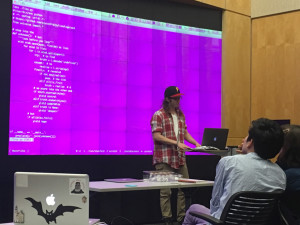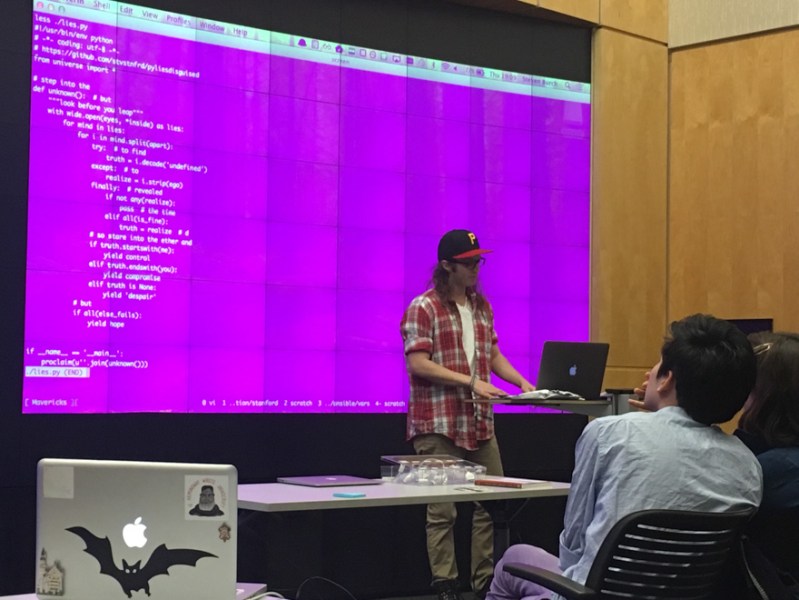Last Thursday, Steven Burch won the Code Poetry Slam Contest with his poem “PyLiesDisguised.” Originally from western Pennsylvania, Burch moved to California to work at a start-up and as a recruiter for an environmental non-profit organization. Burch is currently the technical lead for the Stanford OpenEdX Project, which is an open-source online learning platform.
Code poetry is a form of literature that combines poetry and computer science. For example, a code poet could utilize the syntactic structures of programming languages to create a poem. During the poetry slam, Burch read the input file aloud as a poem. He then ran the program using an algorithm, producing an image of the eye of Horus. Other contestants decided to read their poems aloud or use a computer-generated voice. The Daily sat down with Burch to discuss his hobby and his winning entry in the competition.
The Stanford Daily (TSD): What got you interested in code poetry?
Steven Burch (SB): I have a CS background. I’ve always written code. I also have a slight humanities background. I majored in French as an undergraduate as well. For me, languages are forms of expression. They are ways to communicate ideas. The same idea can be represented and understood by other people. But the beauty is that things can’t be universally translated. That’s what I found very appealing about code poetry. Code is something we typically expect to have exactly one meaning — ones and zeros interpreted by a machine. But rather, we give a creative side to that and have code that can be textually reinterpreted and mean different things to differ people. It’s an interesting challenge.
TSD: Why did you submit to the code poetry contest in particular?
SB: I had actually heard about the contest before I started working at Stanford. I was already interested in it, so then when I caught wind of it again, I figured it’d be a good excuse to dust off my dusty notebook and start writing again, which I haven’t done for a long time. But also the idea of being able to share works. If I’m going to invest time and energy into something, it’s nice to let other people hear it and experience it as well, but also to see what other people were working on. I was really curious to see other submissions from around the world. You have people across the country. It was really cool to collaborate in that manner.

TSD: Can you tell us a little more about the poem you submitted? For example, the language, the output, etc.?
SB: I chose Python as my main programming language because I think it lends itself very well to mimicking human language, specifically English. It doesn’t use as much punctuation as other languages — fewer parentheses, fewer brackets, fewer semicolons and the like. It just lends itself to being read more naturally. It also has a very strong standard library. It does a lot out of the box. I had extra key words and extra things to work with without redefining my own constants.
What I like about my work is that it was functioning code. It actually did something — it didn’t just look pretty. Specifically, what I was going for were the three pieces that worked together.
There was an input file, which had invisible whitespace characters that meant something to the computer. [The input] looked like a piece of English poetry. The algorithm itself is meant to be read by computers. Wanting [the program] to do something is where the ASCII art eye came in. The idea of truth and what you can see is what initially drew me to the eye of Horus, especially since this algorithm worked by finding whitespace characters that the human couldn’t see, but the all-seeing eye could see.
TSD: Can you please go through how all of the parts of the poem fit together?
SB: So there’s an input text file. The bulk of it is an English poem, but it also contains special whitespace characters that can be keyed on by the algorithm. Then there’s the Python file — the algorithm that reads this input. And then based on where and when it finds the whitespace character, it is able to generate the output file, which ultimately produces the eye of Horus.
TSD: Where do you see code poetry going in the future as more and more people learn how to code? Do you think more people will be drawn to this field?
SB: In certain regards, there will always be a certain niche there. I don’t necessarily see it as something everyone and their mother is going to be doing. For me, it’s about drawing a larger appreciation for the craft. As a full-time engineer, even when I’m solving a hard mathematical or science-based problem, there’s very much the idea of how can I distill this down so I’m saying as little as possible but communicating my idea as clearly as possible. [Doing] that in a way that sounds clever and sounds fun makes the craft and the trade itself more approachable for other people.
TSD: Do you have any advice for other people who want to get started with code poetry, either those who do know how to code or those who don’t know how to code?
SB: Just write code. If you’re not writing code, you’re not coding, If you’re not writing poetry, you’re not a poet. So just write!
Contact Anne-Marie Hwang at amhwang ‘at’ stanford.edu.
